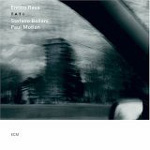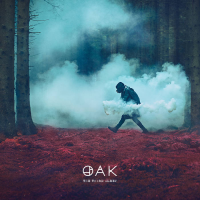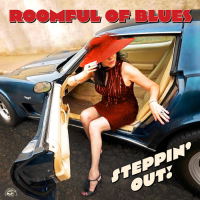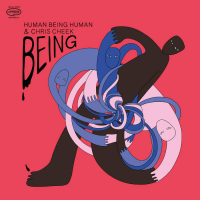Home » Jazz Articles » Extended Analysis » Robert Glasper: Robert Glasper: Canvas
Robert Glasper: Robert Glasper: Canvas
 Robert Glasper
Robert GlasperCanvas
Blue Note Records
2005
Wow! That's the first expression that came to mind when I heard "Rise and Shine, the opening track on Canvas. Pianist Robert Glasper's trio—including Vicente Archer on bass and Damion Reid on drums—is as tight as a unit can. This aptly named tune, sure to help many a dreary eye awaken, sizzles from start to finish. And it's just a prelude of things to come.
The music is straightforward piano jazz—such as that performed and recorded by McCoy Tyner, Chick Corea, Andrew Hill, Bud Powell and many others. However, the album is a lesson in contradictions—or at least it appears to be. Glasper is primarily a pianist, but he also plays Fender Rhodes on three tracks and the kalimba on "Chant. Tenor saxophonist Mark Turner joins the ensemble on two tracks, including the nearly six-and- a-half-minute "Riot, where everyone gets into the groove.
Born in the post-Vietnam era, Glasper identifies with the hip-hop community. It's been my experience that hip-hop and jazz are two cultures that simply do not mix. Jazz lovers enjoy the instrumental complexities of their music—the freedom the artists have to play a song differently each time they hit the stage. On the other hand, there's a sameness to a lot of hip-hop that's out there—not just in the songs by one artist, but also in the genre as a whole. Artists tend to follow the same formula: Get a vocalist to sing or rap, a keyboardist for backup, throw in a monotonous bass line and programmed drum patterns, and you're done.
Of course, the process is more complicated than that, but the resulting sound isn't. Maybe it's on me for not exploring the different approaches to hip-hop, something I'm loathe to do. Not only do I object to the lyrics, I find it musically horrible. Then again, that may be the fault of the marketers, corporate radio executives and television. After all they're the ones who determine what hip-hop the general audiences hear. And what I hear from my 18-year-old's player is bland at best, exceedingly awful at worst.
Glasper, 26, was reared in Houston, Texas. His strongest musical influence was his mother, who sang gospel and played piano in the family's church, as well as playing jazz and blues clubs. During his development, Glasper played with such artists as Christian McBride, Russell Malone, Kenny Garrett, Nicholas Payton, Roy Hargrove, Terence Blanchard, Carmen Lundy and Carly Simon. His first album, 2003's Mood, was released on an independent label. Two years later, Blue Note came calling, leading to the creation of Canvas, a collection of nine Glasper originals and one cover: Herbie Hancock's Riot.
Certainly, there have been crossover attempts. Artists such as Les McCann, Bob James and Ronnie Laws have melded some elements of hip-hop into their music. In those cases, the distinctions were quite clear. Their own instrumentation maintained the jazz elements, while the presence of a scratcher or hip-hop vocalist represented the other part of the equation. However, on Canvas, I'm just not hearing it. Vocalist Bilal's muffled presence on "Chant does add an urban flavor, but that hardly affects the whole album. To be sure, it's not all old-school jazz so much as it is freely played with acoustic instruments. A few of the songs are more melodious, such as the hauntingly beautiful "Remember, a tribute to Glasper's mother. That said, the simple fact that Glasper encourages his sidemen to just play, as opposed to following a script, seems to refute any idea that this music has any connection to hip-hop.
"I get sick of my own music if I know how it's going to end, how I'm going to play it, Glasper says. "So when I give music to the band, I don't dictate it too much, so I can be surprised, too.
There you go. Maybe I'm missing something, but this album is jazz, plain and simple. If Glasper intended to draw a hip-hop audience, I'd say he failed miserably. But from a jazz standpoint, he scores a major hit. Canvas is a superb album with some fine performances by all.
Track listing: Rise and Shine, Canvas, Portrait of an Angel, Enoch's Meditation, Centelude, Jelly's Da Beener, Chant, Riot, North Portland, Remember
Personnel: Robert Glasper: piano, Fender Rhodes, kalimba; Vicente Archer: bass; Damion Reid: drums; Mark Turner: tenor sax (2,8); Bilal: vocals (8,10).
Track Listing
Rise And Shine; Canvas; Portrait Of An Angel; Enoch's Meditation; Centelude; Jelly's Da Beener; Chant; Riot; North Portland; I Remember.
Personnel
Robert Glasper
pianoVicente Archer
bassDamion Reid
drumsMark Turner
saxophone, tenorBilal
vocalsRobert Glasper: piano, Fender Rhodes, kalimba; Vicente Archer: bass; Damion Reid: drums; Mark Turner: tenor sax (2,8); Bilal: vocals (8,10).
Album information
Title: Canvas | Year Released: 2019 | Record Label: Blue Note Records
Tags
PREVIOUS / NEXT
Robert Glasper Concerts
Support All About Jazz
 All About Jazz has been a pillar of jazz since 1995, championing it as an art form and, more importantly, supporting the musicians who make it. Our enduring commitment has made "AAJ" one of the most culturally important websites of its kind, read by hundreds of thousands of fans, musicians and industry figures every month.
All About Jazz has been a pillar of jazz since 1995, championing it as an art form and, more importantly, supporting the musicians who make it. Our enduring commitment has made "AAJ" one of the most culturally important websites of its kind, read by hundreds of thousands of fans, musicians and industry figures every month.
























